Economy
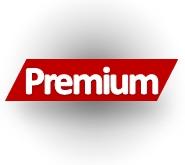
Producer Prices: Pace of Growth Slows in August
Written by David Schollaert
September 15, 2021
Editor’s note: Steel Market Update is please to share this Premium content with Executive members. For information on how to upgrade to a Premium-level subscription, email Info@SteelMarketUpdate.com.
Producer prices expanded further in August, albeit at a slower rate. The gains continued, however, maintaining the historic climb for the index and subcategories for final demand, which have fully recovered from the pandemic-driven collapse and have overtaken pre-pandemic levels.
Since the fall in early 2020, the composite Producer Price Index (PPI) of all commodities from the Bureau of Labor Statistics (BLS) has gained ground month-on-month for 15 consecutive months. August’s index registered a 0.4% gain against the prior month, seasonally unadjusted. Additionally, the index is up 13.7% year-to-date, and is 11.5% higher than the previous high set in June 2014.
The PPI data, which covers more than 10,000 goods and services, is helpful in comparing the direction of price changes in the short and medium term. In specific, this analysis is intended to provide subscribers with a view of the relative competitive positions of sheet steel, aluminum, plastic and wood. It also includes some downstream products and a comparison of truck and rail transportation.
The composite PPI for all commodities (Figure 1) tumbled by more than 4.0% at the onset of the pandemic last spring. The recovery has been exceptional for the U.S. economy and historic for the steel industry. On an unadjusted basis, the final demand index moved up 19.7% for the 12 months ended in August. The PPI is presently at 232.2 in August, up from 231.2 in July, and from 194.0 one year ago.
SMU’s benchmark hot-rolled coil price range stood at $1,900-$2,000 per net ton with an average of $1,950 per ton FOB mill, east of the Rockies as of Sept. 14. The past year’s surge in steel prices, which may or may not have peaked, has been evidence of rising producer prices. Although the average edged down $5 per ton week on week, the runup has been historic.
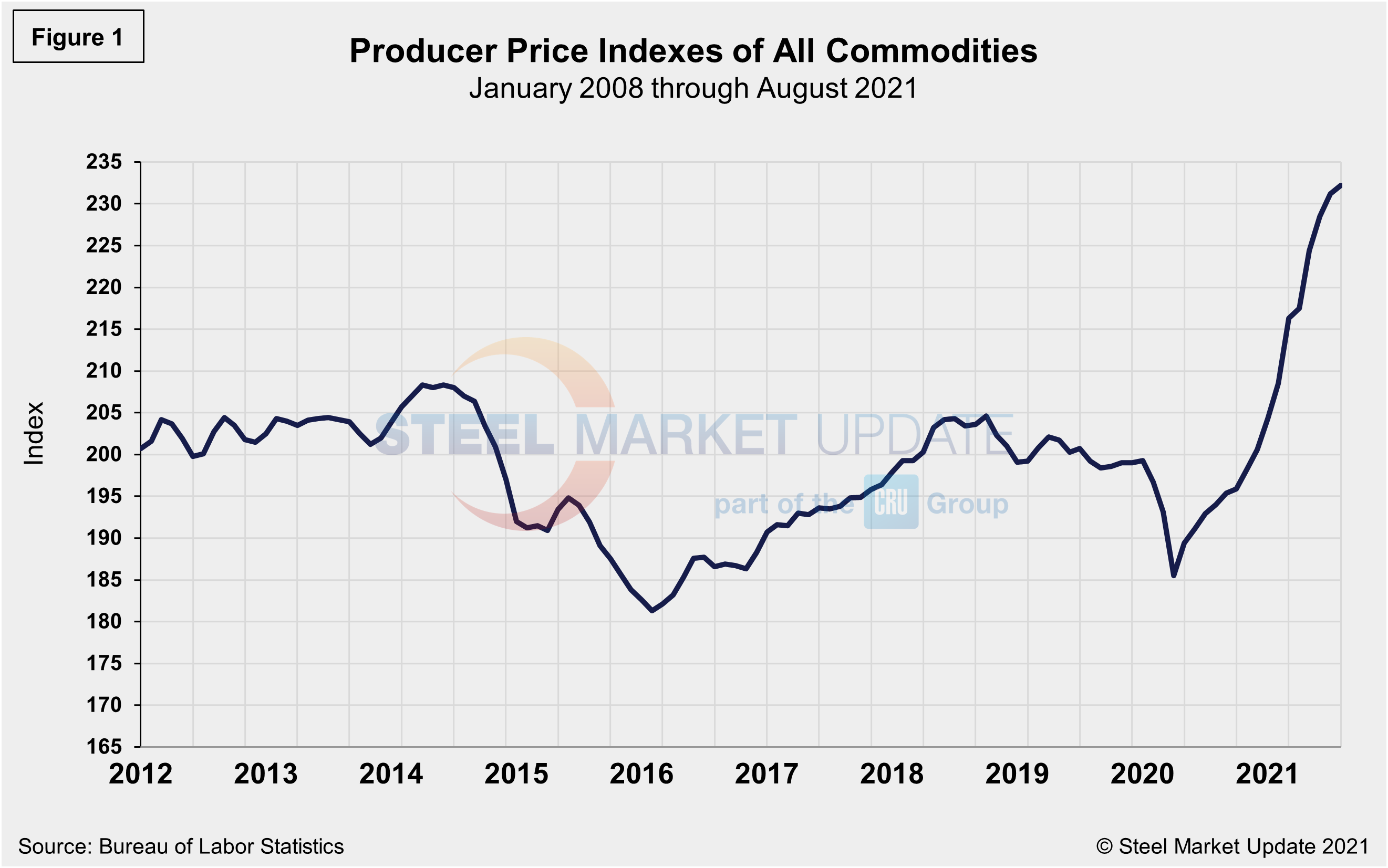
A summary of each segment on a year over one-, two- and three-year basis is shown in the table below. The gain/loss pattern is shown by the color codes; rising prices are considered positive. The positive swing on a 12-month basis would be expected, especially after the initial pandemic-driven slowdown and subsequent rebound. The fact that the table is entirely green at the 24-month and 36-month level, and still trending up, is a testament to the historic recovery and growth trajectory for the overall economy. Through August, all 16 sectors are now on the rise at the 12-month level, with HR and CR carbon steel sheet and strip showing huge increases of 217.3% and 221.4%, respectively. The 24-month and 36-month increases are of even greater impact, as they include pre-pandemic periods.
The table includes direct comparisons where possible between steel and competing products, while also including plastic products, transportation, warehousing and storage to further highlight current market conditions. Even though there may not be a direct or specific comparison of steel, these PPI numbers clearly match the trend of rising demand and prices seen across the steel market. Construction-related products are up anywhere from 15.5% to 76.6% at the 12-month level, with similar increases for the 24- and 36-month periods as well. The marketplace has been resilient, surpassing every speculated high. Despite some recent slowdown in the rate of rise, current prospects are still largely pointing up.
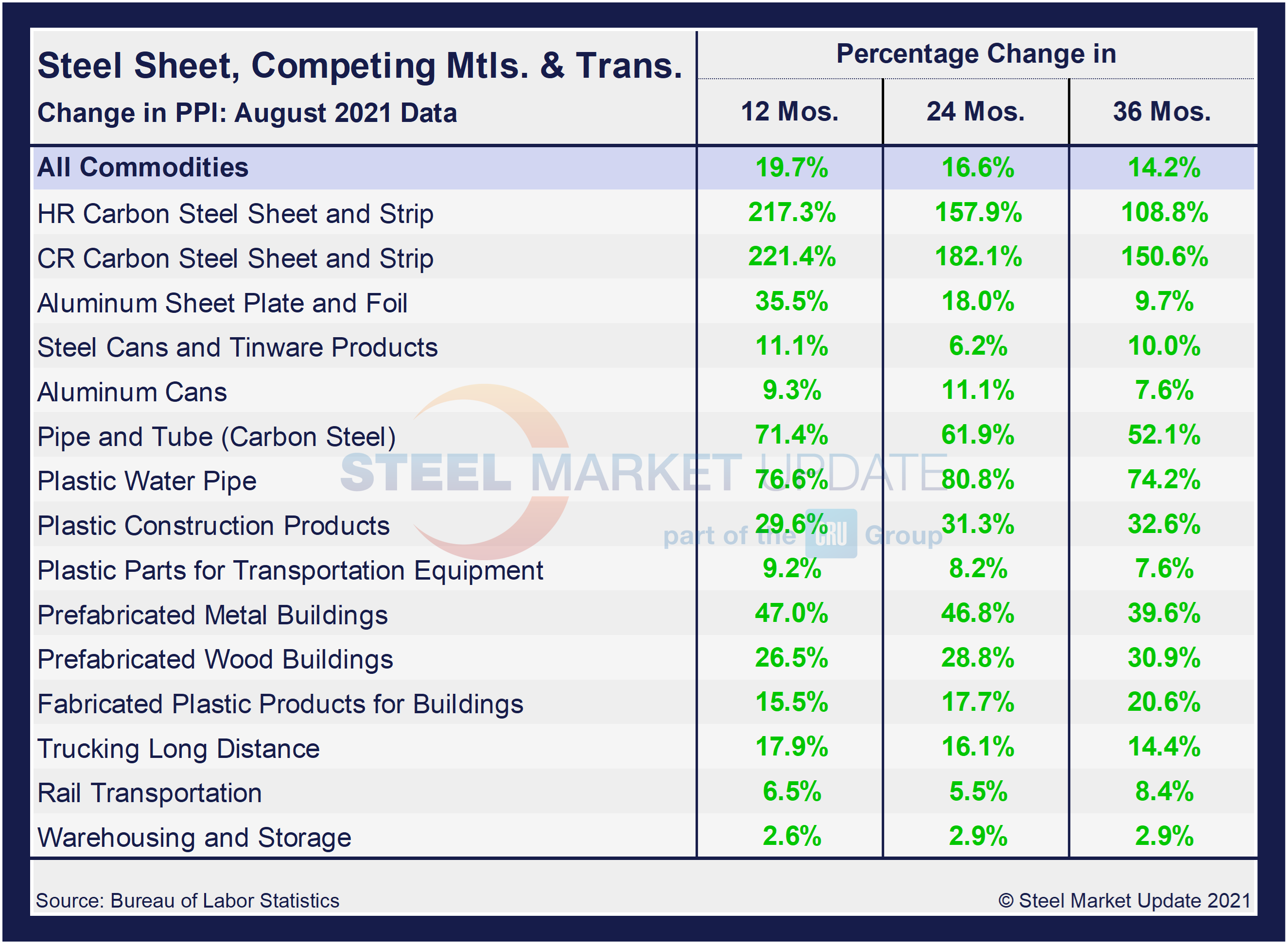
Both steel and aluminum products (Figure 2) have overtaken pre-pandemic PPI figures and reached recent highs. Steel products, however, have shown no real signs of slowing down. Comparing the price changes of cold rolled steel sheet and flat rolled aluminum, the lines have crossed and then reversed only a handful of times over the past five years. Both have recovered from last year’s losses, however, cold rolled steel sheet prices continue to trek towards otherworldly levels through August, overshadowing the impressive rebound in flat rolled aluminum.
Cold rolled steel prices reached positive territory in December for the first time since May 2019 and have since jumped by 221.4% through August. Flat rolled aluminum, by comparison, reached a positive 35.5% in August. Cold rolled steel price gains have shown significant growth since July, overtaking and maintaining greater growth on a percentage basis over hot rolled steel prices. Cold rolled prices surged 22.9% in July, but were a more ordinary 1.5% higher month on month in August.
Although aluminum prices are still well behind steel in terms of growth, they have improved month on month since October when growth was a negative 10.0%. In contrast, steel tinware and aluminum cans have remained largely stable over the past 13 months, as their gains and losses have not been as accentuated. Both aluminum cans and steel tinware were sideways in July, but up 8.3% and 10.5% year on year through August, respectively.
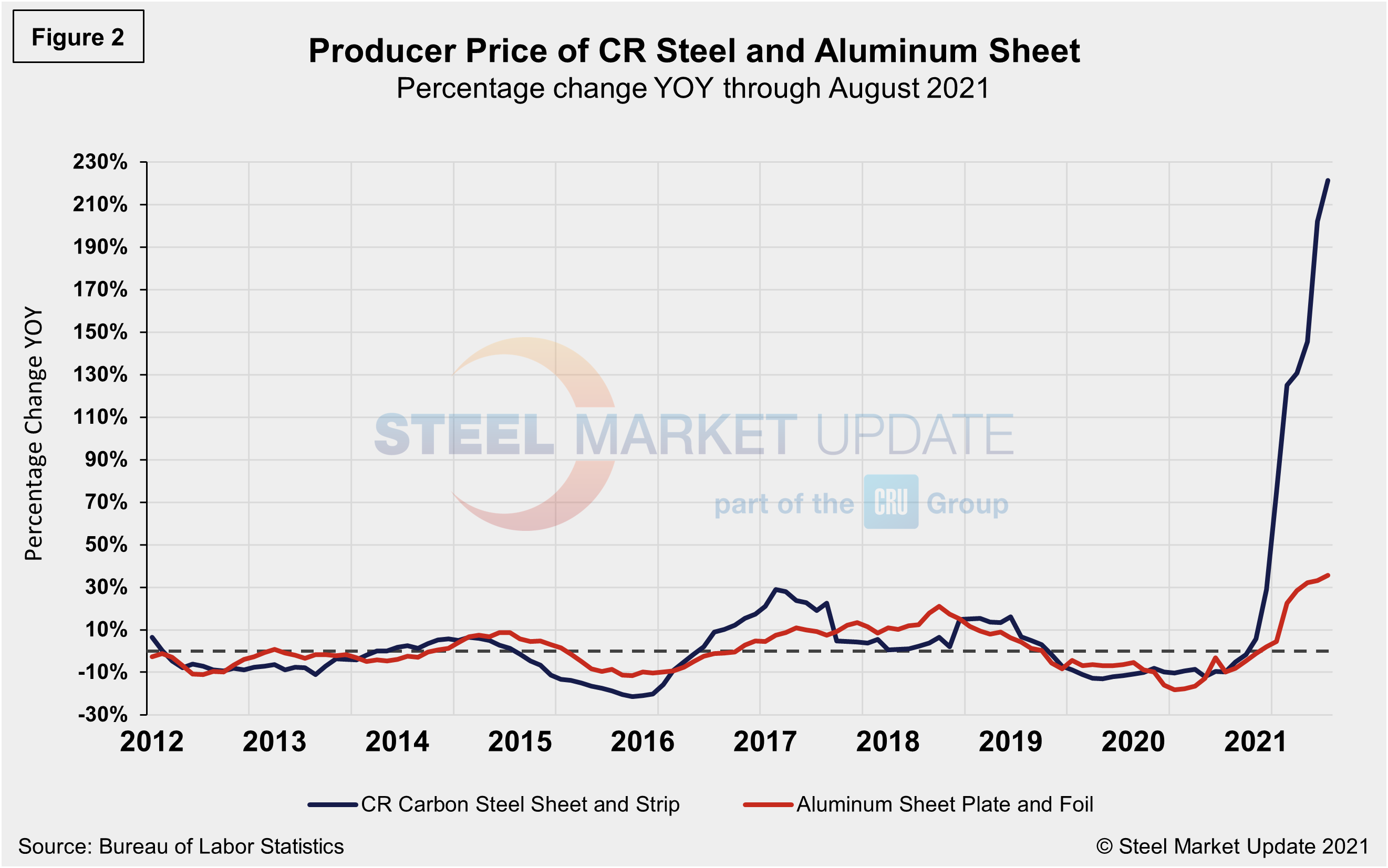
Prices of prefabricated metal buildings and prefabricated wood buildings have both seen significant increases since the beginning of 2021, but the rate of growth has slowed over the past two months. Prefabricated steel building prices fell to a negative 3.5% last June, but rallied to a positive 47.0% over 14 months. A similar trend was seen for prefabricated wood buildings over the same period, at 26.5% growth. Despite a slowdown in the pace of growth, the upward momentum continued in August.
The prices of steel and plastic pipe have both experienced big swings due to COVID-19 as well. Steel pipe prices dropped to a negative 8.0% through September last year, but rallied to a positive 71.4% through August after a 6.6% jump month on month. By comparison, plastic pipe has rallied by more than 52.0% since January, reaching a positive 76.6% growth in August on a year-on-year basis. Figure 3 is a side-by-side comparison of prefabricated buildings and pipe price dynamics.
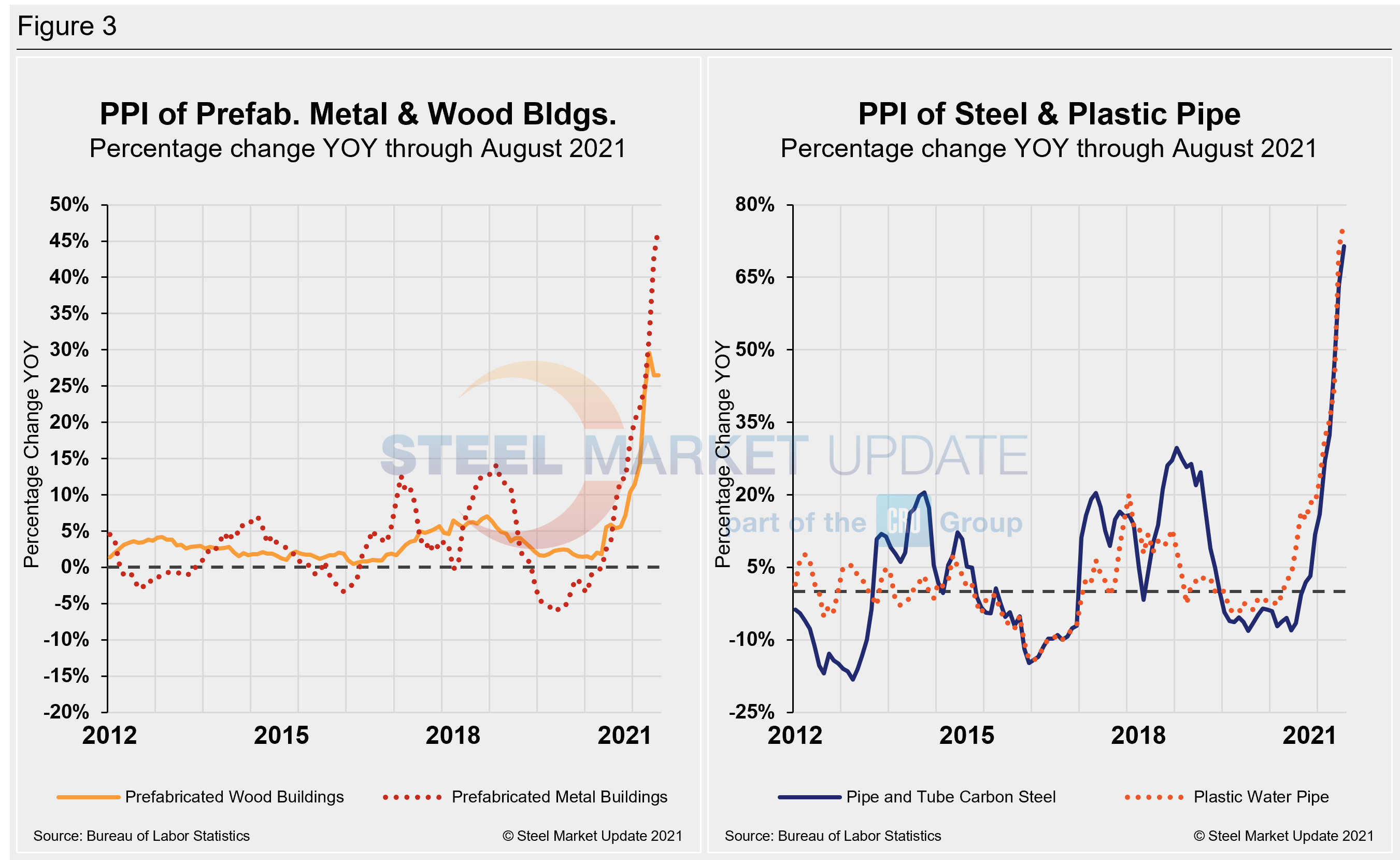
The escalation of truck transportation prices has far exceeded those of rail (Figure 4) since they both bottomed out in June of last year. Rail dipped to a negative 1.7% last June and has since slowly corrected to a positive 6.5% through August 2021. Long distance trucking, on the other hand, recovered to positive 24.5% in June after falling to negative 7.5% one year ago, but has since lost some ground down to a positive 17.9% through August. The increased freight pricing over the past year has been a compounding factor to steel buyers already wrestling with historically high finished steel prices. Even though long-distance grew by 0.2% month on month, freight costs have experienced the most significant increase in more than a decade.
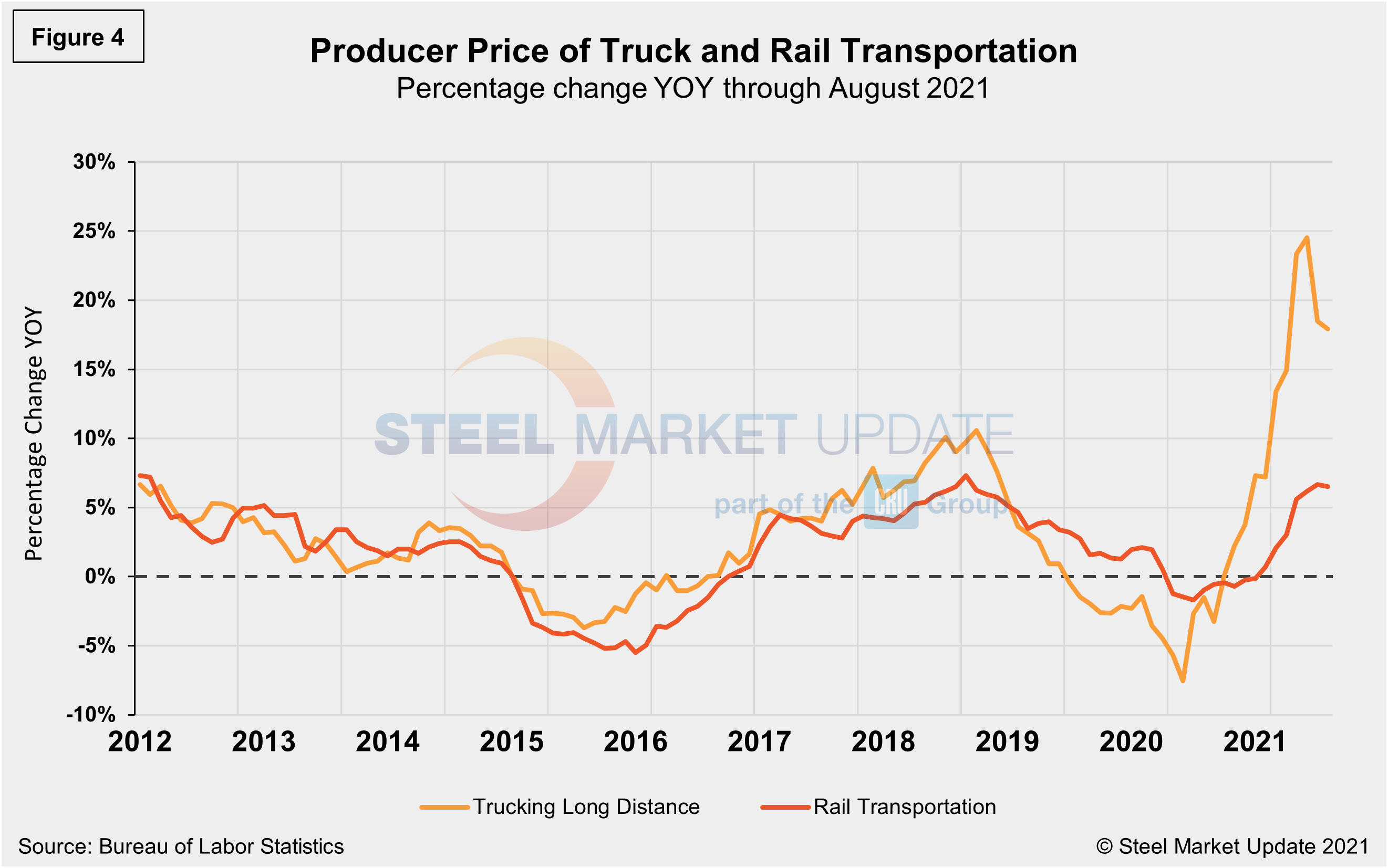
Warehousing and storage prices also have rallied. After initially falling to a negative 2.3% at the onset of the global pandemic, they had rebounded to a positive 6.6% through July. They fell 1.7% month on month through August, showing the first contraction in nearly 15 months.
The official description of this program from the BLS reads as follows: “The Producer Price Index (PPI) is a family of indexes that measure the average change over time in the prices received by domestic producers of goods and services. PPIs measure price change from the perspective of the seller. This contrasts with other measures, such as the Consumer Price Index (CPI). CPIs measure price changes from the purchaser’s perspective. Sellers’ and purchasers’ prices can differ due to government subsidies, sales and excise taxes, and distribution costs. More than 10,000 PPIs for individual products and groups of products are released each month. PPIs are available for the products of virtually every industry in the mining and manufacturing sectors of the U.S. economy. New PPIs are gradually being introduced for the products of industries in the construction, trade, finance, and services sectors of the economy. More than 100,000 price quotations per month are organized into three sets of PPIs: (1) stage-of-processing indexes, (2) commodity indexes, and (3) indexes for the net output of industries and their products. The stage-of-processing structure organizes products by class of buyer and degree of fabrication. The commodity structure organizes products by similarity of end use or material composition. The entire output of various industries is sampled to derive price indexes for the net output of industries and their products.
By David Schollaert, David@SteelMarketUpdate.com

David Schollaert
Read more from David SchollaertLatest in Economy

Steel groups welcome passage of budget bill
Steel trade groups praised the passage of the Big Beautiful Bill (BBB) in Congress on Thursday.

Industry groups praise Senate for passing tax and budget bill
The Steel Manufacturers Association and the American Iron and Steel Institute applauded the tax provisions included in the Senate's tax and budget reconciliation bill.

Chicago PMI dips 0.1 points in June
The Chicago Purchasing Managers Index (PMI) slipped 0.1 points to 40.4 points, in June.

Multi-family pullback drives housing starts to 5-year low in May
US housing starts tumbled in May to a five-year low, according to figures recently released by the US Census Bureau.

Architecture firms still struggling, ABI data shows
Architecture firms reported a modest improvement in billings through May, yet business conditions remained soft, according to the latest Architecture Billings Index (ABI) release from the American Institute of Architects (AIA) and Deltek.
